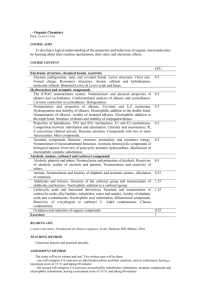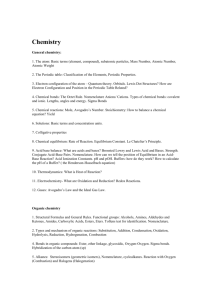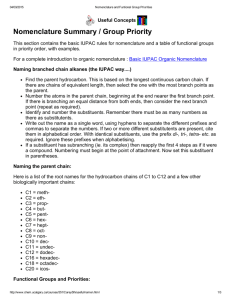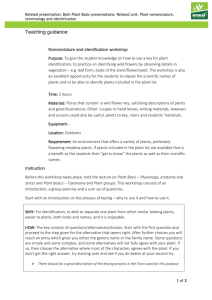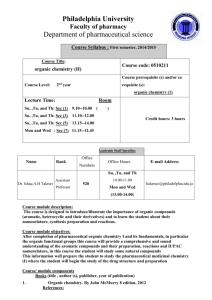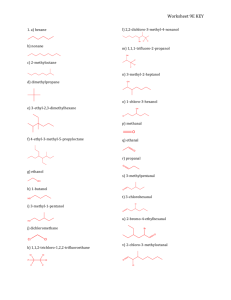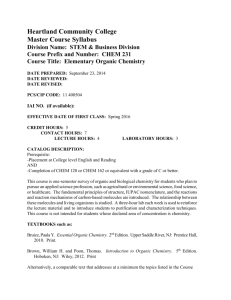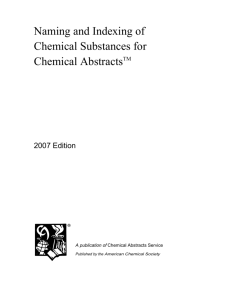Organic Chemistry
advertisement
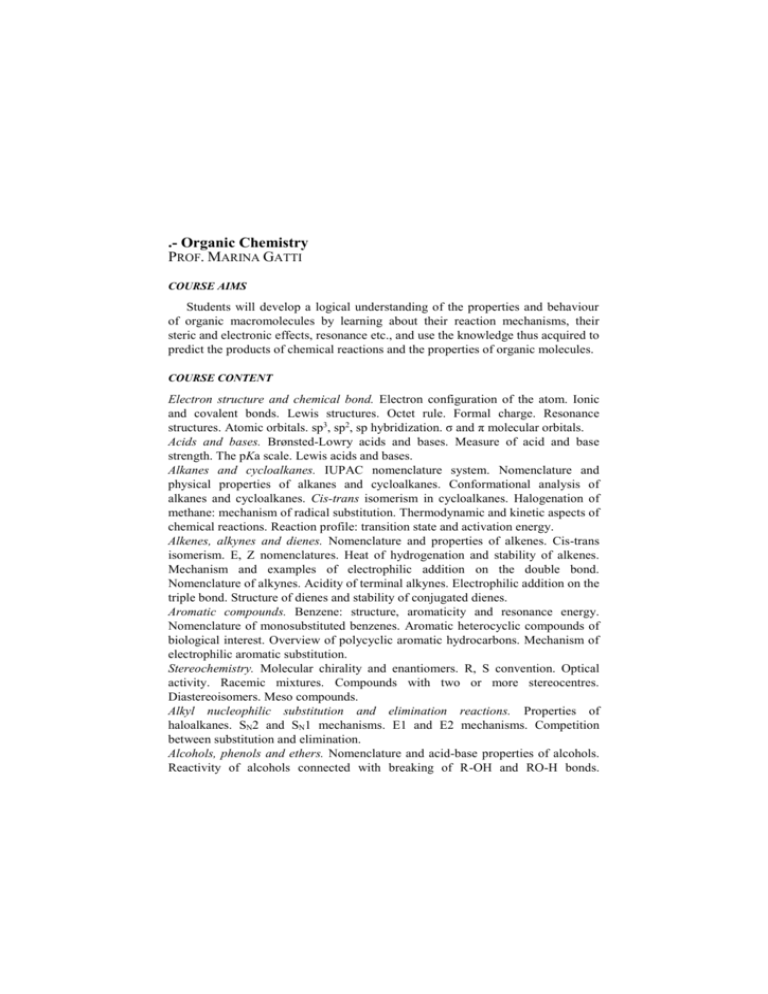
.- Organic Chemistry PROF. MARINA GATTI COURSE AIMS Students will develop a logical understanding of the properties and behaviour of organic macromolecules by learning about their reaction mechanisms, their steric and electronic effects, resonance etc., and use the knowledge thus acquired to predict the products of chemical reactions and the properties of organic molecules. COURSE CONTENT Electron structure and chemical bond. Electron configuration of the atom. Ionic and covalent bonds. Lewis structures. Octet rule. Formal charge. Resonance structures. Atomic orbitals. sp3, sp2, sp hybridization. σ and π molecular orbitals. Acids and bases. Brønsted-Lowry acids and bases. Measure of acid and base strength. The pKa scale. Lewis acids and bases. Alkanes and cycloalkanes. IUPAC nomenclature system. Nomenclature and physical properties of alkanes and cycloalkanes. Conformational analysis of alkanes and cycloalkanes. Cis-trans isomerism in cycloalkanes. Halogenation of methane: mechanism of radical substitution. Thermodynamic and kinetic aspects of chemical reactions. Reaction profile: transition state and activation energy. Alkenes, alkynes and dienes. Nomenclature and properties of alkenes. Cis-trans isomerism. E, Z nomenclatures. Heat of hydrogenation and stability of alkenes. Mechanism and examples of electrophilic addition on the double bond. Nomenclature of alkynes. Acidity of terminal alkynes. Electrophilic addition on the triple bond. Structure of dienes and stability of conjugated dienes. Aromatic compounds. Benzene: structure, aromaticity and resonance energy. Nomenclature of monosubstituted benzenes. Aromatic heterocyclic compounds of biological interest. Overview of polycyclic aromatic hydrocarbons. Mechanism of electrophilic aromatic substitution. Stereochemistry. Molecular chirality and enantiomers. R, S convention. Optical activity. Racemic mixtures. Compounds with two or more stereocentres. Diastereoisomers. Meso compounds. Alkyl nucleophilic substitution and elimination reactions. Properties of haloalkanes. SN2 and SN1 mechanisms. E1 and E2 mechanisms. Competition between substitution and elimination. Alcohols, phenols and ethers. Nomenclature and acid-base properties of alcohols. Reactivity of alcohols connected with breaking of R-OH and RO-H bonds. Comparison of reactivity and acidity of alcohols and phenols. Quinones and biological oxidation-reductions. Nomenclature and reactivity of ethers. Amines. Nomenclature and basicity of aliphatic and aromatic amines. Alkylation of ammonia. Aldehydes and ketones. Structure of the carbonyl group and nomenclature of aldehydes and ketones. Nucleophilic addition to a carbonyl group. Carboxylic acids and functional derivatives. Structure and nomenclature of carboxylic acids, alkyl halides, anhydrides, esters and amides. Acidity of aliphatic acids and α-substituent effects. Nucleophilic acyl substitution: relative reactivity of carboxylic acids and functional derivatives. Bifunctional compounds. Nomenclature of bifunctional organic compounds with particular reference to di- and tri-carboxylic acids, hydroxyl-acids and keto-acids. Reactivity of α-hydrogens to carbonyl C. Acidity of α-hydrogens. Enolization of aldehydes, ketones and esters. Aldol condensation. Dehydration of aldols. Claisen condensation. Fats and oils. Nomenclature and physical characteristics of saturated and unsaturated fatty acids. Soaps and detergents. Waxes and phospholipids. READING LIST W.H. BROWN-C.S. FOOTE-B.L. IVERSON-E.V. ANSLYN, Chimica Organica, 4a ed., EdiSES s.r.l., 2010. K.P.C. VOLLHARDT-N.E. SCHORE, Chimica Organica, 3a ed., Zanichelli, 2005. F.S. LEE-W.H. BROWN-T. POON, Guida alla soluzione dei problemi da introduzione alla chimica organica, 4a ed., EdiSES s.r.l., 2012. TEACHING METHOD The course comprises 6 credits for classroom lectures and 1 credit for practical tutorials. The course includes 12 hours of teaching assistant support. On-line study materials (http://blackboard.unicatt.it). ASSESSMENT METHOD Final oral examination. NOTES Prof. Marina Gatti is available to meet with students after class at the Institute of Agricultural and Environmental Chemistry.
